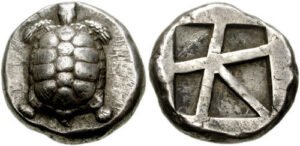Greek Silver Coinage
Earliest Greek Silver Coinage: Origins, Types, and Collector Insights
Earliest Greek silver coinage? Have you ever picked up an ancient Greek coin and wondered where it all began? Not just the art or the myth behind it, but the very first moment someone decided to shape silver into a symbol of trade, power, or even faith? That spark happened over 2,600 years ago, and it changed everything.
Let’s rewind to the earliest days of Greek silver coinage — a time before famous Owls and golden staters flooded the ancient markets.
So, When Did Silver Coinage Actually Start in Greece?
Most experts place the beginning somewhere between 600 and 550 BCE. The Greeks had seen what the Lydians were doing with electrum (a gold-silver mix), but silver felt more “pure” and reliable. Plus, it was easier to weigh and source.
It wasn’t a single city that kicked things off, but a handful of ambitious places:
- Aegina, with its famous turtle coins
- Corinth, known for Pegasus
- Athens, just before its Owl era
- Island cities like Naxos and Eretria
These city-states weren’t just minting coins. They were branding their identity in metal.
Aegina’s Turtle Coins: Small Island, Big First Step
If you ask most collectors where Greek silver coinage begins, they’ll probably point to Aegina.
What did these look like?
- Obverse: A plump sea turtle
- Reverse: A simple punch-mark (nothing fancy)
- Metal: Silver
- Weight: Around 12 grams (a stater)
They weren’t flashy, but they worked. Merchants accepted them from Egypt to the Black Sea. Why? Because Aegina was a trading powerhouse, and trust in its coinage spread fast.
And the turtle? It wasn’t random. Aegina was a naval force. The turtle was a symbol of the sea and strength.
Corinth and Pegasus: Art Meets Commerce
Then there’s Corinth, who took a different approach. If Aegina was about practicality, Corinth was about style.
- Obverse: Flying Pegasus
- Reverse: A geometric motif (often a swastika or cross)
- Date: From around 550 BCE
These coins are just… beautiful. Even worn-down versions show how much effort went into the engraving.
Collectors love them not just for the look, but for what they represented. Corinth wasn’t just selling goods — it was selling itself as a cultured, connected city.
What Was Athens Doing Before the Owl?
Before the famous Owl tetradrachms, Athens minted a few lesser-known silver coins.
- Athena’s early profile
- Sometimes a crescent moon or an early owl attempt
- Simple punch reverse
These coins didn’t travel as widely as later issues, but they tell an important story: Athens was experimenting, getting ready for the silver coinage boom that would come in the Classical period.
How Were These Early Coins Made?
The earliest Greek silver coins were struck, not cast. That meant:
- Melt silver into little blobs (blanks)
- Place one between two engraved dies
- Smash it hard with a hammer
What you got was a one-of-a-kind coin, often slightly off-center, and totally unique. Those little flaws? That’s the charm.
In fact, spotting double strikes or uneven edges is how many collectors verify authenticity.
Why Should You Care as a Collector?
Honestly? These coins are the origin story of Western money. They’re not just rare. They’re important.
- Every detail was carved by hand
- Their spread shows the rise of trust-based trade
- Each one says something about the city that made it
Prices vary, but even modest-condition coins like an Aegina turtle or a Corinthian Pegasus can go for €1,000 to €4,000, sometimes way more at auction.
And there’s nothing like holding a coin that predates the Parthenon.
Final Thought: Coins That Breathed Life into History
You don’t need to be a scholar to appreciate these coins. All you need is curiosity and a bit of respect for the hands that made them. They’re not just currency — they’re messages from the past.
So next time you see a Ancient silver coin with a turtle, or a winged horse frozen in flight, remember: that little disc helped shape the world.
And now, it’s in your hands.
